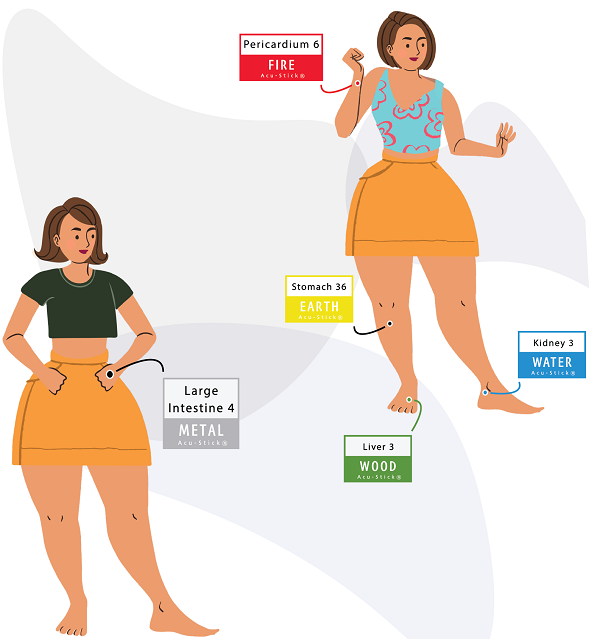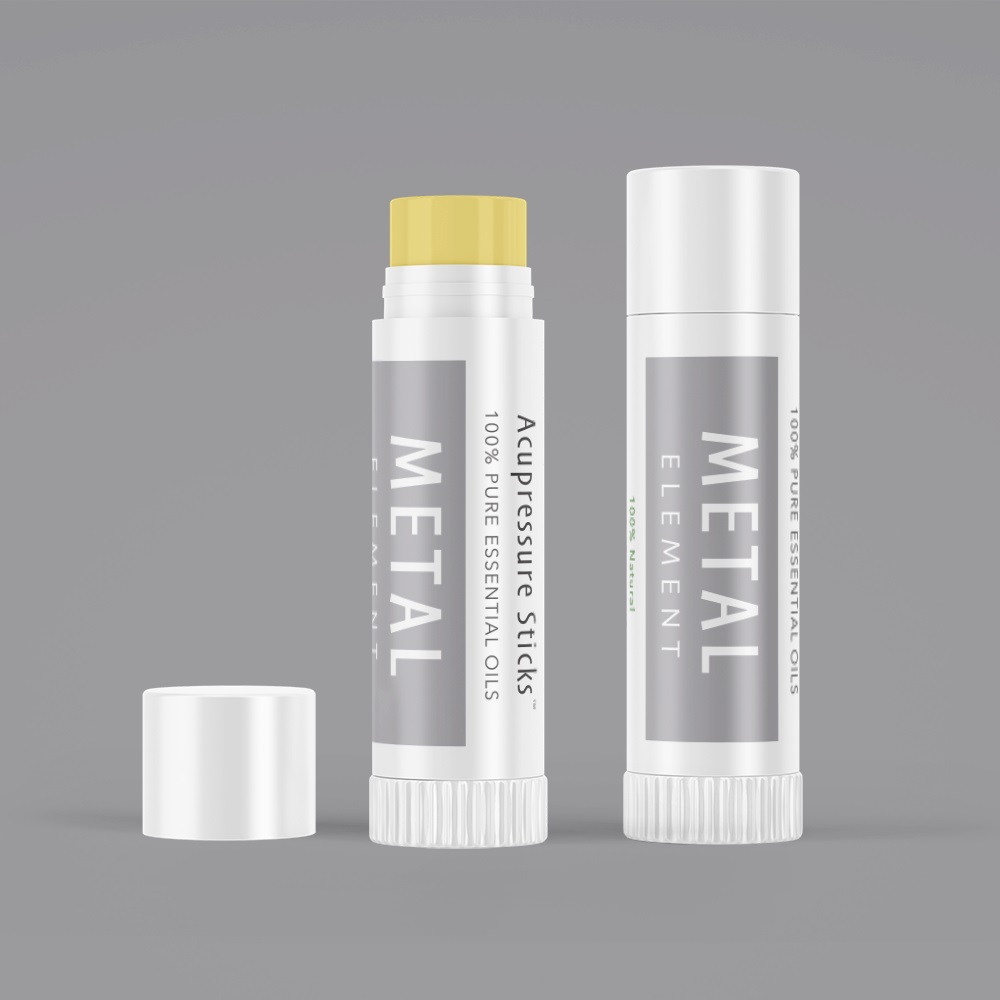Metabolic Syndrome
Metabolic Syndrome in Chinese Medicine
Chinese medicine has always viewed the body as a single organism rather than separate pieces and parts; each organ system has a specific affect on other organ systems, and each organ system supports each of the other organ systems according to Chinese medical theory. True health and wellness is maintained by keeping all of the organ systems healthy and in communication with one another allowing for the free flow of Qi throughout the body. The progression of one chronic disease leads to more diseases in other organ systems in Chinese medicine. For best outcomes using self-care, apply associated Aroma Acu-Sticks® to acu-points, topical remedies, and good lifestyle practices.
![]()
Aroma Acu-therapy™ for Metabolic Syndrome X
Apply the Earth Element Aroma Acu-Stick® to activate Acupressure Point ST 36
Why? Acu-point Stomach 36 benefits the Spleen and Stomach, nourishes Qi and Blood, clears Stomach Heat, and boosts vital energy.
Apply the Metal Element Aroma Acu-Stick® to activate Acupuncture Point LI 4
Why? LI 4 works together with Liver 3 to invigorate the circulation of Blood and Qi and when the two points are used together the therapy is referred to as the "Four Gates" and helps to promote the correct flow of Qi and Blood throughout the body.
Apply the Wood Element Aroma Acu-Stick® to activate Acupressure Point LV 3
Why? LV 3 is the energy source point for the Liver energetic organ system that is able to soothe Liver Qi Stagnation that causes Heat in the body that attacks the Heart and is the underlying cause of high blood pressure
Apply the Fire Element Aroma Acu-Stick® to activate Acupuncture Point Pericardium 6
Why? Acu-point PER 6 is used to regulate Heart Qi and Blood, influences the Spleen Qi, and influences Yin of the body in Chinese medicine.
Kidney 3
Apply the Water Element Aroma Acu-Stick® to activate Acupressure Point KI 3
Why? Acu-point Kidney 3 is the Source Point of the Kidney energetic organ system and is used to tonify Yin which is consumed with chronic Heat according to Traditional Chinese Medicine.
Related Articles:
Causes of Metabolic Syndrome in Chinese Medicine
It is common for metabolic syndrome to present with more than one of these patterns of imbalance since it is a chronic condition that likely affects multiple energetic organ systems.
![]()
Spleen Qi Damage
Insulin resistance, diabetes, and abdominal obesity are three main indicators of metabolic syndrome and would be associated with Spleen Qi Deficiency in Chinese medicine. Another association with the Spleen is high cholesterol levels consider "Sticky Blood" from internal Dampness that has congealed in to phlegm. Internal Dampness is also associated with sleep apnea often seen in cases of metabolic syndrome.
Acupressure Point Combination Strategy:
- Apply the Earth Element Acupressure Stick to Acupressure Point Stomach 36
- Apply the Fire Element Acupressure Stick to Acupressure Point Pericardium 6
- Apply the Earth Element Acupressure Stick to Acupressure Point Spleen 3
- Apply the Earth Element Acupressure Stick to Acupressure Point Spleen 9
![]()
Liver-Heart Element Imbalances
One of the interrelated organ-level imbalances in metabolic syndrome is clearly demonstrated when Liver Qi Stagnation creates Heat that attacks the Heart causing Heart Disease. High blood pressure is associated with both Liver and Heart in Chinese medicine as well. Heat consumes Yin and Yin Deficiency further complicates health conditions. Nonalcoholic fatty liver disease is sometimes associated with metabolic syndrome as well and would indicate Liver Qi Congestion.
Acupressure Point Combination Strategy:
- Apply the Wood Element Acupressure Stick to Acupressure Point Liver 3
- Apply the Water Element Acupressure Stick to Acupressure Point Kidney 3
- Apply the Fire Element Acupressure Stick to Acupressure Point Heart 8
- Apply the Fire Element Acupressure Stick to Acupressure Point Pericardium 6
![]()
Lifestyle Habits to Prevent Metabolic Syndrome
Exercise
Regular exercise and movement are often lacking with those suffering with metabolic syndrome. A brisk walk for 30 minutes per day is especially helpful in keeping the Qi and Blood moving throughout the body. Qi gong, tai qi and yoga helps to strengthen Qi energy available for the organ systems and to increase circulation of Qi and Blood, and regardless of your present health condition, you can benefit from these types of exercises. Exercise also contributes to stress reduction, and stress has been closely related to belly fat and other metabolic diseases.
Diet
It is believed that a chronic over consumption of inappropriate foods leads to metabolic syndrome and guide patients in Chinese food therapy for better health. A diet rich with whole organic foods is most beneficial with metabolic disorders. Refined carbohydrates and any whites including sugar, white rice, white flour, potatoes, and white pasta should be avoided. Rather, look to whole grains when choosing carbohydrates. Raw foods, fruits, juices, iced drinks, and frozen foods should be moderated to avoid injuring the Spleen function. Good oils such as virgin olive oil and cold pressed vegetable oils should be used rather than processed oils. Vegetables, beans (legumes), nuts, and seeds should be consumed in abundance. Meat consumption should be moderated. So called 'diets' should be traded in for new healthy eating habits when dealing with metabolic syndrome.
![]()
Symptoms of Metabolic Syndrome
Metabolic Syndrome X includes the increased risk factor of heart attack, stroke, or diabetes due to specific risk factors:
- High insulin levels, an elevated fasting blood glucose or an elevated post meal
glucose alone with at least 2 of the following criteria: - Abdominal obesity as defined by a waist to hip ratio of greater than 0.9, a body mass index of at least 30 kg/m2 or a waist measurement over 37 inches
- Cholesterol panel showing a triglyceride level of at least 150 mg/dl or HDL cholesterol lower than 35 mg/dl
- Blood pressure of 140/90 or above (Chinese medicine for high blood pressure)
Presently, 25% of adults in the US have symptoms of metabolic syndrome; by 2010, 50-75 million people in the US alone are expected to be afflicted by metabolic syndrome. Obesity, especially with a large percentage of belly fat, is common with metabolic syndrome.
Anyone whose health has deteriorated to this level has been experiencing poor health for some number of years; it will take a minimum of 1-2 years of daily acupressure and good lifestyle practices to bring the body back in to balance. While this may seem extreme, modern western medicine does not offer any true opportunity to return to good health when dealing with chronic health conditions. Yes, there is insulin for diabetes; there are blood pressure medicines; there are cholesterol medicines; but these pharmaceuticals are all designed to stave off further deterioration rather than to heal and restore.
![]()
Zhang HN, He JH, Yuan L, Lin ZB. In vitro and in vivo protective effect of Ganoderma lucidum polysaccharides on alloxan-induced pancreatic islets damage. Life Sci. 2003;73:2307–2319. [PubMed] [Google Scholar]
Yao Z, Zhang L, Ji G. Efficacy of polyphenolic ingredients of Chinese herbs in treating dyslipidemia of metabolic syndromes. J Integr Med. 2014;12(3):135-146. doi:10.1016/S2095-4964(14)60023-6
Yin J, Zhang H, Ye J. Traditional chinese medicine in treatment of metabolic syndrome. Endocr Metab Immune Disord Drug Targets. 2008;8(2):99-111. doi:10.2174/187153008784534330
Hao Z, Hang B, Wang Y. Hypoglycemic effect of fructus Ligustri Lucidi. Zhongguo Zhong Yao Za Zhi. 1992;17:429–5431. 447. [PubMed] [Google Scholar]
Luo Q, Cai Y, Yan J, Sun M, Corke H. Hypoglycemic and hypolipidemic effects and antioxidant activity of fruit extracts from Lycium barbarum. Life Sci. 2004;76:137–149.
Berger A, Rein D, Kratky E, Monnard I, Hajjaj H, Meirim I, Piguet-Welsch C, Hauser J, Mace K, Niederberger P. Cholesterol-lowering properties of Ganoderma lucidum in vitro, ex vivo, and in hamsters and minipigs. Lipids Health Dis. 2004;3:2.
This information has not been evaluated by the Food and Drug Administration. This information is not intended to diagnose, treat, cure, or prevent any disease.






